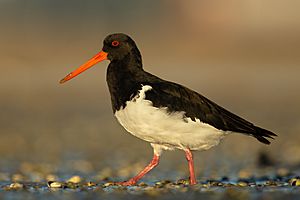South Island oystercatcher facts for kids
Quick facts for kids South Island oystercatcher |
|
|---|---|
 |
|
| Conservation status | |
| Scientific classification | |
| Genus: |
Haematopus
|
| Species: |
finschi
|
The South Island oystercatcher is a special bird found in New Zealand. It's also known as the South Island pied oystercatcher. People sometimes call it "SIPO" for short. This bird is one of two common oystercatchers living in New Zealand.
Contents
What Does It Look Like?
It's easy to spot this bird! The South Island oystercatcher is a large wading bird. It has striking black and white feathers. Its long beak is a bright red-orange color. It also has red legs.
This bird is about 46 centimeters (18 inches) long. Its wings can spread out 80–86 centimeters (31–34 inches) wide. It weighs about 550 grams (1.2 pounds). You can tell it apart from other similar birds by looking at its white lower back and more white on its wings. Also, the line where its black and white feathers meet on its chest is further forward.
Where Does It Live?
The South Island oystercatcher is a bird that is endemic to New Zealand. This means it is only found there naturally. It breeds, or has its babies, inland on the South Island. After breeding season, most of these birds fly to estuaries and harbors on the North Island.
Sometimes, a few birds might fly to other places. They have been seen on Norfolk Island, Lord Howe Island, and the eastern coast of Australia.
Its Home Environment
When they are breeding, these birds like to live near braided rivers. They also live in open fields and farmed areas. You can find them on lake beaches and in high mountain grasslands called tundra and herbfields.
When they are not breeding, they move to coastal areas. They enjoy living in estuaries, bays, beaches, and sandy or muddy areas that are covered and uncovered by the tide.
How Does It Behave?
What Does It Eat?
As its name suggests, the South Island oystercatcher loves to eat. It mainly feeds on molluscs, like shellfish, and worms. It uses its long, strong beak to find and pull them from the mud or sand.
What Does It Sound Like?
This bird makes different kinds of calls. It has piping calls that it uses to talk to other oystercatchers. These calls can be social or used when they are being aggressive. It also has a loud, piercing alarm call if it senses danger. When it flies, it makes a quiet flight call.
Reproduction and Life Cycle
The South Island oystercatcher builds its nest in simple sand scrapes. These can be found in farmland or on gravel banks in braided rivers.
A female bird usually lays two eggs, but sometimes three. The eggs are brown with darker and lighter brown spots. Both the male and female birds take turns sitting on the eggs. This incubation period lasts for 24 to 28 days.
When the chicks hatch, they are quite developed. They can move around and leave the nest soon after hatching. The young birds are ready to fly about six weeks after they are born.
Conservation Efforts
The number of South Island oystercatchers went down a lot in the late 1800s and early 1900s. This was mainly because people hunted them.
However, things changed in 1940. The birds became legally protected, meaning it was against the law to hunt them. Since then, their population has been growing! In 2002, experts estimated there were about 110,000 of these birds. Because their numbers are healthy and increasing, their conservation status is considered "Least Concern". This means they are not currently at risk of extinction.
Images for kids
See also
 In Spanish: Ostrero de Finsch para niños
In Spanish: Ostrero de Finsch para niños



